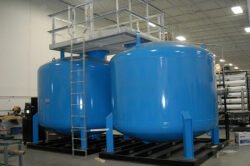Vacuum Degasification in Wastewater Treatment: Principles and Applications

Vacuum degasification in wastewater treatment is an advanced process designed to remove dissolved gases, such as hydrogen sulfide, carbon dioxide, and methane, from wastewater streams. By creating a vacuum within a treatment chamber, gases are drawn out from the wastewater due to the pressure difference. The removal of these gases is crucial for reducing odor, corrosion, and potential toxicity in water before it is discharged back into the environment or reused.
The technology behind vacuum degasification involves a combination of engineering and scientific principles. Key components like vacuum towers, degassing membranes, and pumps work together to create a controlled environment where dissolved gases are efficiently stripped away from the water molecules. Applications of this process are diverse, ranging from municipal wastewater treatment to industrial processes where high water quality is paramount. Proper operation and maintenance of vacuum degasification systems are essential for their effectiveness and longevity.
Key Takeaways
- Vacuum degasification removes harmful gases from wastewater, improving water quality.
- The process relies on a vacuum to extract gases and employs specialized equipment for treatment.
- While effective, the system requires careful maintenance and adherence to regulatory standards.
Principles of Vacuum Degasification
Vacuum degasification is a process used in treating wastewater to remove dissolved gases. This section will detail how vacuum degasification in wastewater operates on a physical level, the chemical principles involved, and the mechanical aspects of creating and maintaining a vacuum.
Physics of Gas Removal
Vacuum degasification relies on the creation of a low-pressure environment where gases dissolved in wastewater become less soluble and begin to separate from the liquid. Gas removal hinges upon differences in partial pressures. Dissolved gases escape into the vacuum because partial pressure in the gas phase is lower than in the liquid, leading to a release of the gases until equilibrium is reached.
Solubility and Henry’s Law
Henry’s Law states that the solubility of a gas in a liquid at constant temperature is directly proportional to the partial pressure of that gas above the liquid. In the context of vacuum degasification, this means that reducing the pressure over the liquid reduces the solubility of gases, driving them out of solution.
- Henry’s Law equation: S = kH * P
- S: Solubility of the gas
- kH: Henry’s law constant (specific for each gas at a given temperature)
- P: Partial pressure of the gas
As vacuum degasification decreases P, the solubility of the gas in the wastewater (S) also decreases.
Vacuum Generation and Maintenance
Achieving and maintaining a vacuum is essential for degasification processes. A vacuum is generated using pumps that remove air and gases to create a low-pressure zone. The efficiency of gas removal is influenced by the quality of the vacuum:
- Stronger vacuums lead to a greater reduction in partial pressures, enhancing degasification efficiency.
- System integrity is critical to prevent air leaks which can compromise vacuum strength.
Vacuum maintenance involves regular monitoring and adjustments to ensure consistent pressure levels are sustained throughout the degasification process.
Design and Components
In the realm of wastewater treatment, vacuum degasification plays a crucial role in removing dissolved gases from liquids. The design and components of such systems are critical in ensuring efficient and consistent removal of these gases.
Vacuum Tower Design
The Vacuum Tower is the heart of the degasification system. It typically features a packed column design to maximize the contact surface area between the water and the vacuum, thus enhancing gas removal. The packing material is chosen based on its surface area, chemical compatibility, and durability. The tower’s height and diameter are determined according to the required flow rates and the degree of degasification needed.
Degassing Equipment
Key to the system, the degassing equipment consists of several components:
- Vacuum Pumps: Create a low-pressure environment necessary for degasification.
- Packing Material: Increases the contact surface area, and comes in various forms like structured or random packing.
- Demisters: Positioned at the top of the tower to prevent mist or small droplets from carrying over with the extracted gases.
Control Systems
The efficient operation of vacuum degasification systems is governed by Control Systems which include:
- Sensors: Monitor pressure, flow rates, and gas concentrations.
- Control Valves: Adjust the flow within the system.
- Programmable Logic Controllers (PLCs): Automate the operation and respond to sensor inputs to maintain optimal degassing conditions.
Each component operates in concert to maintain the efficacy of vacuum degasification in treating wastewater, making it a critical aspect of modern wastewater management practices.
Applications and Processes
Vacuum degasification plays a crucial role in water treatment, effectively removing dissolved gases and specific contaminants. This process is versatile, serving various applications from industrial to municipal settings.
Industrial Wastewater Treatment
In industrial wastewater treatment, vacuum degasification is used to remove volatile organic compounds (VOCs) and other gases that can interfere with system processes or must be removed to meet regulatory standards. This treatment can be imperative for industries such as pharmaceutical manufacturing, where product purity is essential.
Municipal Wastewater Systems
Municipal wastewater systems benefit from vacuum degasification by protecting infrastructure and maintaining the biological processes necessary for wastewater treatment. By removing dissolved oxygen and other gases, the risk of corrosion in pipes and tanks is significantly diminished, which prolongs their service life and efficiency.
Specific Contaminant Removal
Vacuum degasification is particularly effective in the targeted removal of specific contaminants such as hydrogen sulfide, a notorious gas for its foul odor and corrosive properties. This process ensures that water meets safety standards and is free from compounds that could pose health risks or operational challenges.
Process Integration
Integrating vacuum degasification into existing water treatment processes is seamless due to its modularity and adaptability. It serves as a complementary stage in a comprehensive treatment system, contributing to the overall efficiency by preparing water for subsequent treatment steps or ensuring the quality of the final effluent.
Operation and Maintenance
Effective operation and maintenance are critical for the optimal performance of vacuum degasification systems in wastewater treatment. Ensuring that standard operating procedures are followed, maintenance schedules are adhered to, and performance is consistently monitored plays a pivotal role in the longevity and efficiency of the vacuum degasification process.
Standard Operating Procedures
For vacuum degasification in wastewater, standard operating procedures (SOPs) are the blueprint for ensuring consistency and safety in operations. SOPs typically describe the start-up sequence, shutdown processes, and step-by-step instructions for the daily operation of the system. Personnel must be trained to understand and execute these procedures properly to mitigate the risk of system failure or inefficient operation.
Maintenance Schedules
Maintenance schedules are essential to preserve the equipment used in vacuum degasification. These schedules should be strictly followed and can include:
- Daily inspections for leaks or irregular sounds
- Weekly checks of the vacuum pump oil levels
- Monthly verifications of the degasifier tower packing
- Quarterly assessments of the system’s valves and sensors
- Annual reviews for the overall system performance
Each component of the vacuum degasification system has its unique maintenance needs, which should be documented and adhered to to prevent unscheduled downtime and costly repairs.
Performance Monitoring
Performance monitoring is the ongoing assessment of the vacuum degasification system. This includes tracking parameters such as:
- Feedwater quality, to ensure it is within the design specifications for the system
- Oxygen removal efficiency, to confirm that dissolved gases are being adequately removed
- Energy consumption, to identify any unusual increases that might indicate a problem
The data collected from performance monitoring provides insights into the health of the system and is often used to fine-tune operations for maximal effectiveness. Operators should promptly address any deviations from expected performance metrics to maintain the integrity of the wastewater treatment process.
Benefits and Limitations
Vacuum degasification is a critical process in treating wastewater to remove dissolved gases. It is lauded for its precision but is also subject to constraints related to cost and environmental factors.
Efficiency and Effectiveness
Vacuum degasification in wastewater is highly effective at removing unwanted gases, such as oxygen and carbon dioxide, which can be corrosive to piping systems and interfere with subsequent treatment processes. Utilizing a vacuum to create a pressure differential increases the gas removal rate from the water, ensuring a more thorough purification compared to traditional methods.
Economic Considerations
While vacuum degasification systems can reduce long-term maintenance costs by protecting infrastructure from gas-related corrosion, the initial investment and operational expenses are considerable. These systems often require significant energy to sustain the vacuum and manage the extracted gases, which can have financial implications for water treatment facilities, especially those processing large volumes of wastewater.
Environmental Impact
The environmental impact of vacuum degasification is generally positive as it results in cleaner water and reduces the potential for corrosive damage to the environment. However, it must be managed carefully to avoid the unintended release of removed gases into the atmosphere, which could contribute to greenhouse gas emissions or localized air quality issues. Proper containment and treatment of these gases are necessary to ensure a net positive environmental outcome.
Regulations and Standards
Vacuum degasification in wastewater treatment is governed by a set of stringent regulations and standards. These are designed to ensure the safety, efficacy, and environmental compatibility of the degasification process.
Local and Federal Guidelines
Local and federal agencies set forth specific regulations that dictate the acceptable parameters for vacuum degasification in wastewater systems. For instance, the Environmental Protection Agency (EPA) mandates the reporting of greenhouse gases for certain facilities, which may include those utilizing vacuum degasification techniques. Facilities must adhere to 40 CFR Part 98 — Mandatory Greenhouse Gas Reporting to track and report their emissions. Standards may differ based on state and municipality, requiring operators to stay well-informed of their local statutes as well as federal requirements.
Industry Best Practices
In addition to legal requirements, industry best practices play a crucial role in vacuum degasification applications in wastewater treatment. Organizations often look to professional associations and expert guidelines to adopt methods that go beyond compliance. For example, the integration of real-time monitoring systems is recommended to ensure continuous efficacy and control. This falls in line with practices encouraged by resources like the Methane Emission Measurement and Monitoring Methods, which discusses the importance of emissions monitoring for environmental protection. Following these best practices is essential for facilities to minimize their environmental impact while optimizing the vacuum degasification process.
Case Studies
Vacuum degasification in wastewater treatment has proven to be an efficient technology for the removal of unwanted gases, enhancing both municipal water treatment processes and industrial water applications.
Municipal Water Treatment Successes
In municipal settings, vacuum degasification systems are critical for ensuring the safety and quality of water. The Town of Springfield, for instance, implemented a vacuum degasification system that significantly reduced dissolved gases, including hydrogen sulfide and carbon dioxide, from their municipal water supply. This application allowed for consistent compliance with environmental regulations and improved the odor and taste of the potable water.
In another example, the City of Lakeside incorporated vacuum degasification equipment to combat high levels of nitrogen in the wastewater. This effort was successful as it allowed the city to meet stringent discharge standards and mitigate eutrophication in neighboring water bodies.
Industrial Implementation Examples
Industrially, vacuum degasification has played a pivotal role in water-intensive processes. A renowned paper manufacturing company utilized the technology to remove oxygen from the water used in their production process, which significantly prolonged the life of their equipment by reducing corrosion rates. The ability to control the levels of dissolved oxygen led to improved product quality and operational efficiencies.
Similarly, a large-scale cooling system for a data center employed vacuum degasification to remove corrosive gases from the water. This action extended the life of the cooling infrastructure and ensured consistent cooling performance, thereby protecting critical IT equipment from overheating risks.
Future Perspectives
Vacuum degasification in wastewater treatment is poised for impactful evolution. Emerging technologies, sustainability measures, and market shifts will define its trajectory in the years ahead.
Technological Advancements
Advances in vacuum degasification technology are expected to enhance efficiency and broaden the range of applications. Innovations could include improved vacuum pump designs that offer higher operational performance and lower energy consumption. Additionally, there may be a transition towards systems that can effectively remove a wider array of contaminants, thereby improving water quality and expanding the usability of treated wastewater.
Sustainability Initiatives
In the sustainability realm, vacuum degasification processes are likely to be integrated with renewable energy sources, such as solar or wind power, to decrease the carbon footprint of wastewater treatment plants. This integration could lead to the design of autonomous systems capable of operating off-grid, which would be particularly beneficial for remote areas lacking infrastructure.
Global Market Trends
The global market for vacuum degasification is anticipated to expand, driven by stringent environmental regulations and the growing demand for high-quality water in various industries. Developed regions are likely to remain at the forefront of adopting cutting-edge wastewater treatment solutions, while emerging economies may see increased investment as they work to improve water management and sanitation standards.
Frequently Asked Questions
What methods are commonly used for degassing water in industrial settings?
Industrial settings often employ several methods for degassing water, including membrane contactors, forced draft deaerators, and vacuum degasifiers. The chosen method depends on the specific applications and requirements of the process involved.
How does vacuum degassing compare to other water treatment processes?
Vacuum degassing operates at lower temperatures and pressures compared to other water treatment processes, making it energy efficient. It specifically targets dissolved gases, such as oxygen and carbon dioxide, and is effective in preventing oxidation and corrosion in water systems.
What advantages does vacuum degasification offer over distillation in water purification?
Vacuum degasification is more energy-efficient than distillation because it does not require changing the water's phase to steam. It is also generally faster and can effectively remove dissolved gases without the need for high temperatures.
In what ways does vacuum degassing specifically benefit wastewater treatment?
Vacuum degassing benefits wastewater treatment by removing volatile organic compounds (VOCs) and preventing the formation of unwanted byproducts. This enhances the effectiveness of subsequent treatment processes and helps meet stringent environmental discharge standards.
How does the removal of gases from water through vacuum degassing affect water quality?
The removal of gases from water through vacuum degassing improves water quality by reducing corrosion risk, enhancing process control, and contributing to the stability of the treated water. This is essential for industries that rely on high-purity water for their operations.



